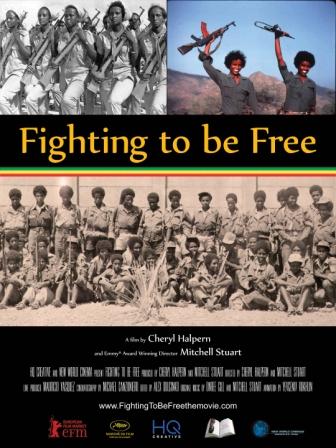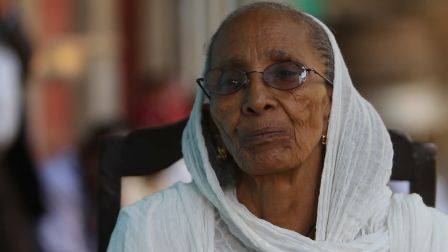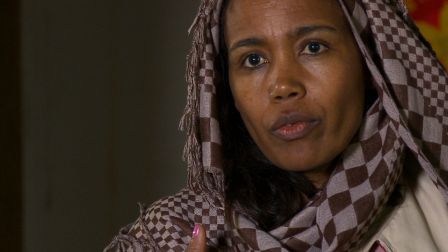 |
Cheryl Halpern: Her Royal Highness
Filmmaker
|
 |
Cheryl Halpern, a female filmmaker whose films have
won many esteemed film festivals around the world, was inaugurated
with a Royal Nobility Title of the Kingdom of Tallo, South Sulawesi.
Cheryl Halpern is a woman of full charisma. She dedicated her life
to humanity. Among them are through her inspirational films (WishMakers,
Two Zions: The Living Legacy of the Queen of Sheba and King Solomon,
Natsanat, Fighting to be Free) and through her social activities in
the United States. She received this honor in Bali, in November
2017.
Blanketed with humbleness and tears, Cheryl Halpern who was deeply
moved by this honor promised to continue working for others and
helping disadvantaged children in Indonesia--a country she will
always welcome as a family.
This time, the Film Reporter has interviewed her for her winning
film, Fighting to be Free, which have been chosen as the Best Film
from the Directors Awards.
|
Cheryl Halpern, is a co-founder and partner of HQ Creative LLC, an
Emmy Award winning production company and branding agency serving
clients throughout the world.
Mrs. Halpern has a long record of public service in broadcasting,
education and international affairs.
Mrs. Halpern was nominated to serve on the boards of America’s
international and domestic broadcasting organizations by Presidents
George H.W. Bush, Bill Clinton and George W. Bush. She served on the
Board for International Broadcasting as a director of Radio Free
Europe/Radio Liberty. Mrs. Halpern also became a member of the newly
formed U.S. Broadcasting Board of Governors overseeing Voice of
America, Radio and TV Marti, Worldnet, RFE/RL, Radio Free Asia, and
Radio Free Iraq. She was also confirmed to serve as a director of
the Corporation for Public Broadcasting (CPB) and was elected by the
board to serve two terms as the chairman.
In addition to her service in public broadcasting, Cheryl Halpern
served as a Public Delegate of the United States, with the rank of
Ambassador, to the 63rd Session of the General Assembly of the
United Nations.
In her capacity as a Presidentially appointed US delegate to the
Organization for Security Cooperation in Europe’s Conference on
Anti-Semitism, Mrs. Halpern addressed the plenary on children’s
programming and textbook development. During the Obama
Administration she was confirmed as a member of the U.S. Holocaust
Memorial Council.
Mrs. Halpern has also chaired several NGO’s including the character
education program of the Words Can Heal organization; a national
campaign to curb gossip, fight verbal violence and promote the
healing powers of ethical speech. As the current chairman of the
Queen of Sheba Foundation she has partnered in the development of “Midako”,
an illustrated children’s book publishing initiative to promote
literacy in Ethiopia. Together with her “Midako” colleagues in
Ethiopia, Mrs. Halpern is in the process of creating an animated
children’s series for Ethiopian television. Expanding beyond
Ethiopia, Mrs. Halpern is providing educational support for children
from the Batwa tribe in northern Uganda.
As a documentarian, Mrs. Halpern has produced several commissioned
as well as independently produced films. Most notably, the
government of Ethiopia commissioned Mrs. Halpern and her HQ Creative
LLC team to produce a memorial documentary to the late Prime
Minister, Meles Zenawi. A special tribute to Prime Minister Zenawi
was also produced for screening at the 50th Anniversary of the
African Union.
Mrs. Halpern’s independently produced documentaries have provided
compelling historical and cultural information to her audiences. Her
films embody the spirit of achievement and provide positive visual
images and messages for all; regardless of age, gender or ethnicity.
Her documentaries have been screened around the world by film
festivals and educational institutions. They have also been included
in Museum exhibits and library collections.
In 2016, the World Tolerance Awards committee presented Mrs. Halpern
with the Tolerance Woman of the Year Award. She also received the
A.F.I. World Peace Initiative’s Cinema and Humanitarian Award. In
2017, Mrs. Halpern was awarded the NYC International Film Festival’s
Humanitarian Award. She also received the Highest Honor of Peace
Prize from the International Film Festival for Peace, Inspiration
and Equality. Cheryl Halpern was presented in 2017 with the Royal
Highness Nobility Title from the Kingdom of Tallo, on the island of
Sulawesi, Indonesia
She lives in New Jersey with her husband and executive producer,
Fred. |
Q: Could you please
share with us how Fighting to be Free evolved?
I had been working together with AzebMesfin, the then First Lady of
Ethiopia on an educational initiative. During a breakfast meeting,
Azeb and several of her friends began reminiscing about their
teenage years when they chose to join the fight for freedom. Hence
the name, “Fighting to be Free.” I was unaware of what these women
had endured during the17 years of the Derg Regime and I felt
compelled to tell their stories.
Q: Did you have any unusual difficulties during filming?
There were no “unusual” difficulties during the filming process.
There was however a 24 hour delay that we encountered getting our
cameras and equipment cleared through Ethiopian customs.
|
  
|
Q: Will winning awards help promote the film? How so?
One never knows what actually attracts an individual to come and
view a film. However, having award laurels on the promotional poster
for a film encourages greater consideration for an individual to
join the audience. In addition, being selected for screening at Film
Festivals that have existed for a number of years also provides for
a loyal audience. The Film Festival screenings and award laurels
allows for a positive review to be developed and received by the
potential viewer.
Q: How much money did it cost?
This documentary would qualify as a low budget project. The women
were excited to be given a chance to tell their story. Their
enthusiasm encouraged many of the professionals, particularly in
Ethiopia,to volunteer their time and expertise in order to complete
this documentary and share the story with audiences around the
world.
Q: Where were the shooting and post-production locations?
The shooting was done on location in various sites in Ethiopia and
in the United States.
Q: Any bites yet from distributors?
There has been some interest but nothing as yet has come to
fruition.
Q: What has been the feedback so far for the documentary?
The audience feedback has been very positive. During the Q&A
sessions following the screenings the audiences have wanted to learn
more about these women and their fight for freedom and equality.
Q: What was the best part of the project?
The best part of the project was having the opportunity to engage
and learn from these heroic women. These female freedom fighters;
literate and illiterate, rural and urban, created a sisterhood that
defied cultural norms in a struggle for freedom during the latter
part of the 20th century. I am privileged to be called their friend.
Q: Are you pleased with the overall outcome?
“Fighting to be Free” has received accolades from diverse audiences
around the world. It has exceeded my expectations.
Q: What are your hopes and dreams for the film?
I hope that the women who are presenting themselves in “Fighting to
be Free” will serve as role models for other women who are also
seeking to achieve peace and equality.
Q: How long did it take to complete the film?
The documentary took approximately two years to complete.
Q: How do you feel to have won many awards, including the Best Film
from the Directors Awards?
It is personally gratifying to be so acknowledged. It affirms for me
that I have fulfilled my obligation to the women who trusted me to
tell their personal stories responsibly.
Q: Why is this subject important to you? What moved you to make such
a brave and inspiring documentary?
My parents taught me through their actions that we all have a
responsibility to do what we can to make a difference; regardless of
gender, race, ethnicity or religion. I have been guided by these
values and the sense that every day is an opportunity to listen,
learn, make a difference and celebrate life. During times of
conflict women and children are often the first victims. It is
important to recognize that women, even teenagers, can stand up
against oppression and succeed. As such, I felt a compelling need to
share the stories of these remarkable and heroic women through this
documentary.
Q: Does this film send the message you intended?
I believe that it is important to support and applaud women who have
committed themselves to improving the quality of life both locally
within their communities and nationally within their countries. This
documentary effectively tells the story of young women who risked
their lives to achieve freedom and succeeded to then have gender
equality included as an article in Ethiopia’s Constitution.
Q: Do most people just turn a blind eye when they hear of these
issues?
No. Quite the opposite.
As I listened to what was shared with me at that breakfast meeting
with the First Lady and her friends I was embarrassed by my
ignorance regarding the brutality of the Derg and I was in awe of
the heroism that these women showed as they fought to bring closure
to the “Evil Days of the Derg.” My reactions have been echoed by
individuals who have attended the screenings. There is an initial
shock felt by the audience when exposed to the murderous reality of
the Red Terror. Then there is applause for these young women who
left their families and took up arms against superior forces to
bring freedom, peace and democracy to their country.
Q: Why the title 'Fighting to be Free'?
The women in this documentary were “Fighting to be Free” for women
in Ethiopia then and now. They began as heroic female freedom
fighters who created a unique sisterhood of rural and urban,
literate and illiterate young women. They then challenged cultural
norms and emerged as leaders within the armed struggle for freedom.
Finally they were able to champion the inclusion of gender equality
in the Ethiopian Constitution and thereby provide a continuing
legacy to insure freedom for future generations of Ethiopian women.
They were “Fighting to be Free” and they won.
Q: How many awards the documentary has won?
“Fighting to be Free” was released in March 2017. It has been
screened and has won a number of awards in film festivals in Asia,
Europe and the United States. It qualified for OSCAR consideration
as a short documentary. I expect that it will continue to be
selected for future screenings.
Q: Are you working on any new projects?
I am currently working on a new project that tells the stories of
individuals who chose to put their lives at risk, as civilians, in
an effort to stand up against evil. It is a different focus with
regard to time and location but can be considered as complementary
to “Fighting to be Free.”
Q: Can you share with us your new project? When will it start?
Research and filming for this new project have already begun. |
|
Related links:
|
|
|
|

